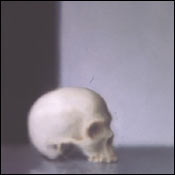
In The Fugitive, the police are always bursting into a room only to find a half-finished drink, an open book, and a cigarette still burning in the ashtray – everything, that is, but the mysterious fugitive himself. In postwar European art, the German painter Gerhard Richter is a similarly elusive figure. He is the artist who is always escaping from the clinging expectations of style, the one who steals away from the prison of definitions. His painting is full of physical presence and intimate effects – like those half-opened books and glowing cigarettes – and yet something in his work remains fundamentally beyond reach. He paints simultaneously in different styles (or disguises). He moves back and forth between public and private preoccupations, between larger and smaller scales, and between abstract and figurative approaches. In the large retrospective of paintings that Robert Storr has organized for the Museum of Modern Art, Richter is the provocative blur somewhere at the center.
For most postwar German artists, of course, the history of the twentieth century is profoundly disquieting. Now 70 years old, Richter, who grew up in East Germany, experienced at firsthand the totalitarian conviction of both Nazism and Communism. In the sixties, he settled in West Germany and, like many other artists of his generation, found Joseph Beuys a powerful inspiration. Beuys did not ignore the demons of German history: He confronted them. In his early painting, Richter took up some of the themes of Pop Art, working with photographs and popular imagery, but it soon became apparent that his ambitions were different from those expressed in, say, the passive “wow” of Warhol’s art. Not only did Richter address historically fraught imagery – such as a photo of a smiling Nazi soldier – but he actively worked upon the character of the imagery. He used hazy gray tones and smudged his images somewhat, as if to unfocus a photograph. There would be no clear answers from an artist recoiling from the plague of totalitarian certainties.
Subsequently, Richter brought this liberating “unfocus” to almost every aspect of his life as an artist. Before he could be pigeonholed as a Pop artist, he also became an abstract painter, one who made not only bright, hard-edged abstractions that resembled color charts but also meltingly poetic monochromatic pictures. Over the years, time itself seemed to lose its direction as he concurrently worked both with past styles – such as Abstract Expressionism – and with newer forms of art. Within individual pictures, too, there was often nothing fixed. A series of images of a nursing mother – his wife – flickered with change; even that archetypal subject could have no stability. And not since Whistler had a painter so closely identified with the shadowy moods of gray. Richter’s grays dissolved the certainties of both form and politics, creating a private space where not everything could be known. The color itself seemed to be mixed from old black-and-white photographs, the overcast light of Northern Europe, and the ashes and dust of existential thought. When he addressed the deaths in prison of members of the Baader-Meinhof group – a subject that invited the screaming clarity of the ideological – he chose to use the deepest grays.
It is easier to respect than to enjoy a painter like Richter. Many people fear constant change, which can seem unstable or promiscuous – even a mark of virtuoso insincerity in an artist. Yet Richter’s determination to remain free from all constraints has provided a paradoxical consistency to his work, and for those interested in the predicaments of modern culture, he is an emblematic figure. He has come to represent our self-consciousness and our doubts about whether truth can be embedded in any artistic style. You cannot easily lose yourself completely in a single Richter painting, for you are always aware of his other approaches. At the same time, Richter is not just another clever postmodern ironist. In making a picture, he seems inside as well as outside the image, believing in and not just questioning his styles, at once judge and perpetrator. In his art, you seem to look through the hazy scrim of history at something essential but half lost.
Gerhard Richter
At the Museum of Modern Art; through 5/21.